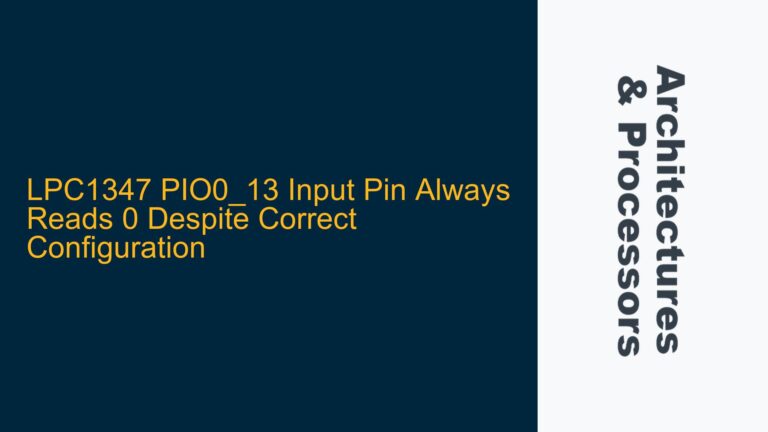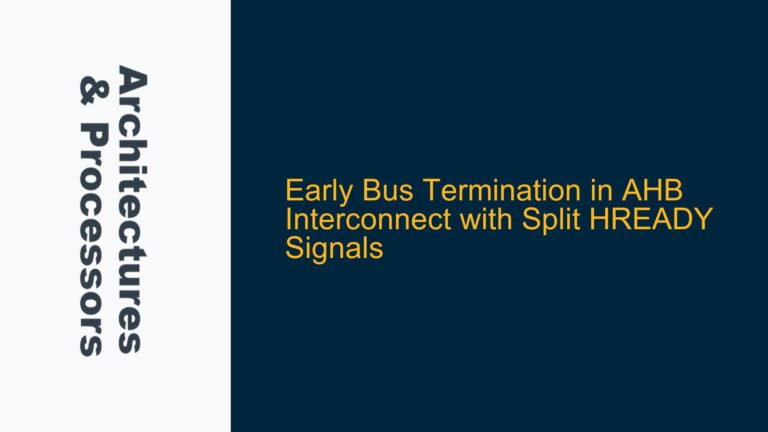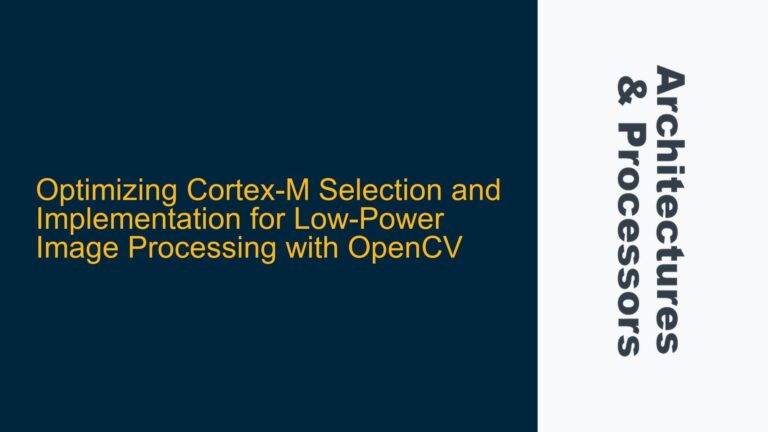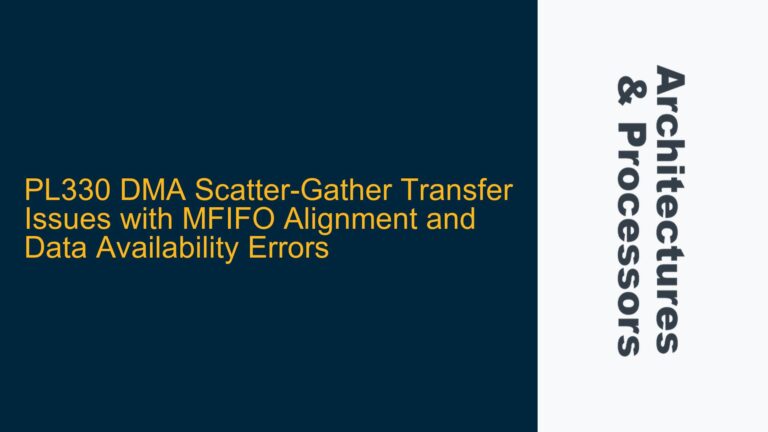Neoverse N1 ARMv8.2 ISA and Optional ARMv8.3 PAC Extension Support
The Neoverse N1 microarchitecture is primarily based on the ARMv8.2 instruction set architecture (ISA), which provides a robust foundation for high-performance computing tasks. However, the ARMv8.2 ISA is not the only version supported by the Neoverse N1. The architecture also allows for optional extensions from later versions of the ARMv8 ISA, such as ARMv8.3, ARMv8.4, and ARMv8.5, as well as cryptographic extensions. These extensions are not included by default and must be licensed separately. This modular approach allows system-on-chip (SoC) designers to tailor the processor to specific use cases, such as enhancing security with ARMv8.3 Pointer Authentication (PAC) or accelerating cryptographic operations with ARMv8.2-SHA and ARMv8.2-SM extensions.
The ARMv8.3 ISA introduces Pointer Authentication (PAC), a critical feature for modern security applications. PAC uses cryptographic signatures to verify the integrity of pointers, mitigating common exploits such as return-oriented programming (ROP) and jump-oriented programming (JOP). While the Neoverse N1 does not natively include ARMv8.3 support, ARM allows partners to implement ARMv8.3 features, including PAC, on top of the ARMv8.2 foundation. This flexibility is a key advantage of ARM’s licensing model, enabling customization to meet specific security and performance requirements.
The cryptographic extensions, such as ARMv8.2-SHA and ARMv8.2-SM, are also optional and must be licensed separately. These extensions introduce new Advanced SIMD instructions that accelerate cryptographic algorithms like AES (Advanced Encryption Standard) and SHA (Secure Hash Algorithm). For example, the ARMv8.2-SHA extension includes instructions for SHA-1, SHA-224, and SHA-256, while the ARMv8.2-SM extension provides support for the SM3 and SM4 algorithms used in Chinese cryptographic standards. These extensions are particularly valuable for applications requiring high-speed encryption and decryption, such as secure communications and data storage.
Licensing Model for ARMv8.3 PAC and Cryptographic Extensions
ARM’s licensing model for ISA extensions is designed to provide flexibility and scalability for SoC designers. The base ARMv8.2 ISA is included with the Neoverse N1, but additional features such as ARMv8.3 PAC and cryptographic extensions must be licensed separately. This modular approach allows partners to implement only the features they need, reducing costs and complexity for applications that do not require advanced security or cryptographic capabilities.
To implement ARMv8.3 PAC on a Neoverse N1-based SoC, a partner must obtain a license from ARM for the ARMv8.3 ISA. This license grants access to the technical documentation and design resources needed to integrate PAC into the processor. Similarly, cryptographic extensions such as ARMv8.2-SHA and ARMv8.2-SM require separate licenses. These licenses include detailed specifications and implementation guidelines, ensuring that partners can successfully integrate the extensions into their designs.
The licensing process typically involves contacting ARM directly or working with an authorized distributor. ARM provides comprehensive support throughout the licensing process, including technical assistance and access to documentation. For example, the ARM Architecture Reference Manual for ARMv8 (DDI0487) is publicly available and provides detailed information on the ARMv8 ISA, including optional extensions. However, access to specific implementation details for licensed extensions, such as ARMv8.3 PAC, is restricted to licensed partners.
Implementing ARMv8.3 PAC on Neoverse N1-Based SoCs
Implementing ARMv8.3 PAC on a Neoverse N1-based SoC requires careful planning and execution. The first step is to obtain the necessary licenses from ARM for the ARMv8.3 ISA and any other desired extensions. Once the licenses are secured, the partner can begin the design process, which involves integrating the PAC functionality into the processor’s instruction pipeline and memory management unit (MMU).
The PAC feature uses cryptographic signatures to protect pointers from tampering. When a pointer is created, a signature is generated using a secret key and stored alongside the pointer. When the pointer is dereferenced, the signature is verified to ensure that the pointer has not been modified. This process requires additional hardware support, including a cryptographic engine for generating and verifying signatures, as well as modifications to the instruction set to support the new PAC instructions.
In addition to hardware changes, implementing PAC also requires software support. The operating system and compiler must be updated to generate and handle PAC instructions. For example, the compiler must be modified to insert PAC instructions when creating and dereferencing pointers, while the operating system must manage the secret keys used for signing and verifying pointers. ARM provides detailed documentation and tools to assist with these modifications, including compiler patches and operating system updates.
Once the hardware and software modifications are complete, the SoC must undergo rigorous testing to ensure that the PAC functionality works correctly and does not introduce performance bottlenecks. This testing includes both functional verification, to confirm that the PAC instructions operate as expected, and performance testing, to measure the impact of PAC on overall system performance. ARM provides test suites and benchmarks to assist with this process, ensuring that the final product meets the required standards for security and performance.
Cryptographic Extensions and Their Integration
The ARMv8.2-SHA and ARMv8.2-SM cryptographic extensions provide significant performance improvements for cryptographic algorithms. These extensions introduce new Advanced SIMD instructions that accelerate common cryptographic operations, such as AES encryption and decryption, as well as SHA-1, SHA-224, and SHA-256 hashing. The ARMv8.2-SM extension also includes support for the SM3 and SM4 algorithms, which are widely used in Chinese cryptographic standards.
Integrating these extensions into a Neoverse N1-based SoC requires similar steps to implementing PAC. The first step is to obtain the necessary licenses from ARM for the desired extensions. Once the licenses are secured, the partner can begin the design process, which involves adding the new instructions to the processor’s instruction set and modifying the Advanced SIMD unit to support the new operations.
The ARMv8.2-SHA extension includes instructions for accelerating SHA-1, SHA-224, and SHA-256. These instructions operate on 128-bit vectors, allowing multiple hash operations to be performed in parallel. For example, the SHA256H instruction performs a single round of the SHA-256 algorithm on a 128-bit vector, significantly reducing the number of cycles required to compute a hash. Similarly, the ARMv8.2-SM extension includes instructions for accelerating the SM3 and SM4 algorithms, which are used in applications such as digital signatures and secure communications.
In addition to hardware changes, integrating cryptographic extensions also requires software support. The operating system and cryptographic libraries must be updated to use the new instructions, ensuring that applications can take advantage of the improved performance. ARM provides detailed documentation and tools to assist with these updates, including patches for popular cryptographic libraries such as OpenSSL.
Once the hardware and software modifications are complete, the SoC must undergo rigorous testing to ensure that the cryptographic extensions work correctly and provide the expected performance improvements. This testing includes both functional verification, to confirm that the new instructions operate as expected, and performance testing, to measure the impact of the extensions on cryptographic workloads. ARM provides test suites and benchmarks to assist with this process, ensuring that the final product meets the required standards for security and performance.
Conclusion
The Neoverse N1 microarchitecture provides a flexible and scalable foundation for high-performance computing tasks. While the base ARMv8.2 ISA includes a wide range of features, optional extensions such as ARMv8.3 PAC and ARMv8.2-SHA/SM provide additional capabilities for security and cryptographic applications. These extensions must be licensed separately, allowing SoC designers to tailor the processor to specific use cases.
Implementing these extensions requires careful planning and execution, including hardware modifications, software updates, and rigorous testing. ARM provides comprehensive support throughout the process, including detailed documentation, tools, and test suites. By leveraging these resources, partners can successfully integrate advanced features such as PAC and cryptographic extensions into their Neoverse N1-based SoCs, delivering high-performance solutions for a wide range of applications.
| Feature | Description | Licensing Requirement |
|---|---|---|
| ARMv8.2 ISA | Base instruction set architecture for Neoverse N1 | Included |
| ARMv8.3 PAC | Pointer Authentication for enhanced security | Licensed separately |
| ARMv8.2-SHA | Cryptographic extension for SHA-1, SHA-224, and SHA-256 | Licensed separately |
| ARMv8.2-SM | Cryptographic extension for SM3 and SM4 algorithms | Licensed separately |
| ARMv8.4/8.5 Extensions | Additional features for performance and security | Licensed separately |
By understanding the licensing model and implementation process for these extensions, SoC designers can unlock the full potential of the Neoverse N1 microarchitecture, delivering high-performance, secure, and efficient solutions for a wide range of applications.






